目录
一.STL简介
1. 什么是STL
2.STL的版本(了解即可)
1.HP STL (原始版本 - 1994年):
-
地位: 由Alexander Stepanov和Meng Lee在惠普实验室开发,是STL的原始实现和概念起源。
-
特点: 开源、模板化、包含核心组件(容器、算法、迭代器、函数对象)。奠定了STL的设计理念和基本架构。
-
现状: 是历史起点,但已不再是主流使用版本。
2.SGI STL (标准化前的重要实现 - 1990年代末):
-
地位: 由Silicon Graphics公司基于HP STL进行大幅改进和扩展的实现。
-
特点:
-
性能优化: 做了大量性能优化,效率很高。
-
扩展组件: 引入了重要的非标准但广泛使用的组件,如
hash_map,hash_set(后来成为标准的unordered_map,unordered_set)、slist(单链表)、rope(长字符串处理) 以及强大的内存分配器(如alloc)。 -
文档优秀: 提供了非常清晰、深入的在线文档,对理解STL内部机制和设计思想影响深远。
-
-
影响: 成为许多早期编译器(如GCC早期版本)STL实现的基础,其设计和扩展组件对C++标准库的发展产生了巨大影响。其文档至今仍是经典学习资料。
-
现状: 本身作为一个独立实现已较少直接使用,但其思想和组件被广泛吸收。
3.STLport (跨平台移植版本 - 1990年代末至2000年代初):
-
地位: 一个旨在提供高性能、跨平台且符合标准的STL实现的开源项目。
-
目标: 解决早期不同编译器(尤其是Windows上的VC++)自带STL实现质量、性能、可移植性和标准符合性不一致的问题。
-
特点: 基于SGI STL,注重可移植性、调试模式支持、标准符合性(努力跟进C++98/03标准)。
-
现状: 在早期VC++(如VC6)时代非常流行,作为替换编译器自带STL的方案。随着主流编译器(GCC, Clang, MSVC)自身STL实现质量的飞速提升和标准化,STLport的重要性已大大降低,项目基本停止活跃。
4.标准库STL实现 (主流编译器自带):
-
地位: 目前绝对主流的STL使用方式。C++标准(C++98/03, C++11, C++14, C++17, C++20, C++23)定义了STL(严格来说是标准库中的容器、算法、迭代器、函数对象等部分)的接口和行为规范。
-
实现者: 各大编译器厂商(或开源社区)负责根据标准规范实现自己的版本:
-
GNU (GCC):
libstdc++(通常称为GNU C++ Library) -
LLVM/Clang:
libc++ -
Microsoft (MSVC): MSVC STL (历史上曾称Dinkumware STL, 现在官方称MSVC STL)
-
其他: Embarcadero C++ Builder, Intel C++ Compiler等也有其实现或适配。
-
-
特点:
-
标准符合性: 严格遵循(或努力追赶)最新的C++标准规范。
-
与编译器深度集成: 紧密配合编译器的特性(如ABI、优化、错误信息)。
-
持续演进: 不断加入对新标准特性(C++11/14/17/20/23)的支持(如移动语义、智能指针、新容器
unordered_map/set,array,forward_list, 并行算法、范围操作等)。 -
性能优化: 各实现都在性能上进行激烈竞争和持续优化。
-
平台适配性: 针对特定操作系统和硬件架构进行优化。
-
-
现状: 是当今C++开发者直接使用的STL实现。选择哪个版本通常取决于你选择的编译器。
总结:
-
HP STL: 始祖,奠定基础。
-
SGI STL: 承前启后,性能卓越,扩展丰富,影响深远(特别是文档)。
-
STLport: 特定历史时期(跨平台/标准符合性需求强烈,编译器实现不佳时)的流行移植方案。
-
编译器自带标准库STL (
libstdc++,libc++, MSVC STL): 绝对主流,严格遵循标准,深度集成编译器,持续演进更新。开发者日常接触和使用的就是这些实现。
主要包括这些内容:
二.string类
2.string类的常用接口说明
2.1构造函数
文档链接:cplusplus.com/reference/string/string/string/



#include <iostream>
#include <string>
using namespace std;
int main()
{
string s1;
string s2("hello world");
string s3(s2);
cout << s1 << endl;
cout << s2 << endl;
cout << s3 << endl;
//cin >> s1;
//cout << s1 << endl;
string s4(s2, 6, 15);
cout << s4 << endl;
string s5(s2, 6);
cout << s5 << endl;
string s6("hello world", 5);
cout << s6 << endl;
string s7(10, 'X');
cout << s7 << endl;
s6[0] = 'x';
cout << s6 << endl;
return 0;
}2.2 string类对象的容量操作

2.3string类对象的访问及遍历操作
迭代器(类似于指针):
正向迭代器:
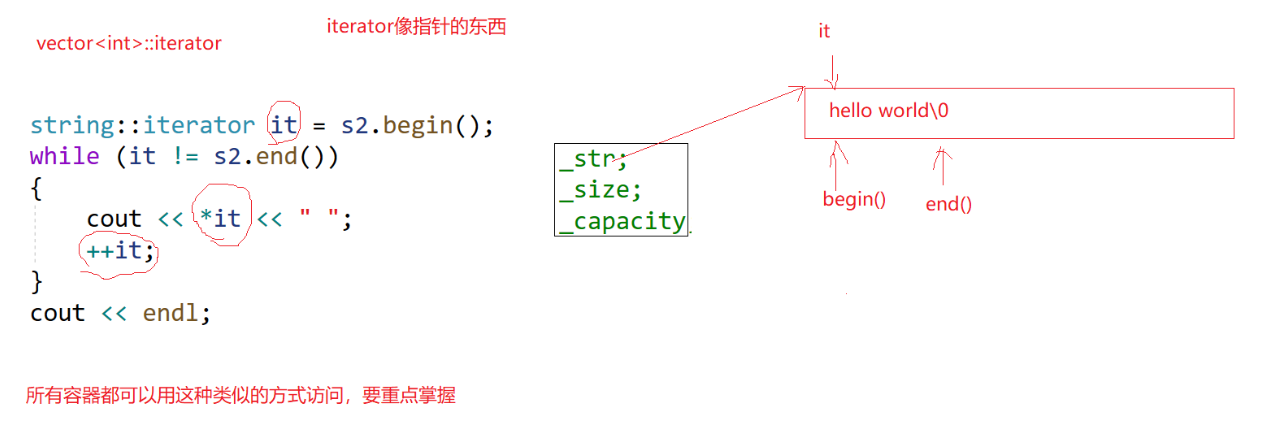
反向迭代器:



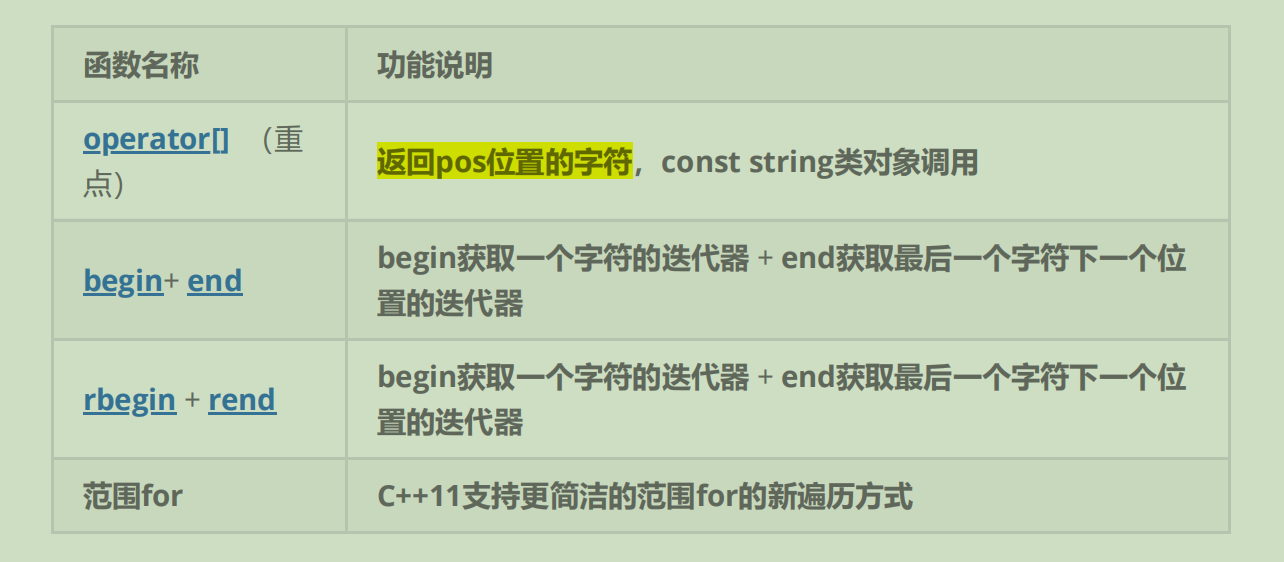
#include<iostream>
#include<string>
#include<map>
#include<list>
using namespace std;
void test_string1()
{
string s1;
string s2("hello world");
cout << s1 << s2 << endl;
s2[0] = 'x';
cout << s1 << s2 << endl;
// 1、下标 + []
for (size_t i = 0; i < s2.size(); i++)
{
cout << s2[i] << " ";
}
cout << endl;
// 2、迭代器
//string::iterator it = s2.begin();
auto it = s2.begin();
while (it != s2.end())
{
*it += 2;
cout << *it << " ";
++it;
}
cout << endl;
cout << s2 << endl;
map<string, string> dict;
//map<string, string>::iterator mit = dict.begin();
auto mit = dict.begin();
/*list<int> lt = { 1,2,3,4,5,6,7 };
list<int>::iterator lit = lt.begin();
while (lit != lt.end())
{
cout << *lit << " ";
++lit;
}
cout << endl;*/
// 3、字符赋值,自动迭代,自动判断结束
// 底层就是迭代器
//for (auto ch : s2)
for (auto& ch : s2)
{
ch -= 2;
cout << ch << " ";
}
cout << endl;
cout << s2 << endl;
}
void test_string2()
{
string s2("hello world");
string::iterator it = s2.begin();
while (it != s2.end())
{
*it += 2;
cout << *it << " ";
++it;
}
cout << endl;
string::reverse_iterator rit = s2.rbegin();
while (rit != s2.rend())
{
cout << *rit << " ";
++rit;
}
cout << endl;
const string s3("hello world");
//string::const_iterator cit = s3.begin();
auto cit = s3.begin();
while (cit != s3.end())
{
//*cit += 2;
cout << *cit << " ";
++cit;
}
cout << endl;
//string::const_reverse_iterator rcit = s3.rbegin();
auto rcit = s3.rbegin();
while (rcit != s3.rend())
{
// *rcit += 2;
cout << *rcit << " ";
++rcit;
}
cout << endl;
}
void TestPushBack()
{
// reverse 反转 逆置
// reserve 保留、预留
string s;
// 提前开空间,避免扩容,提高效率
s.reserve(100);
size_t sz = s.capacity();
cout << "capacity changed: " << sz << '\n';
cout << "making s grow:\n";
for (int i = 0; i < 100; ++i)
{
s.push_back('c');
if (sz != s.capacity())
{
sz = s.capacity();
cout << "capacity changed: " << sz << '\n';
}
}
}
void test_string3()
{
string s2("hello world");
cout << s2.length() << endl;
cout << s2.size() << endl;
cout << s2.max_size() << endl;
cout << s2.capacity() << endl;
TestPushBack();
string s3("xxxxxxxxxxxxxxxxxxxxxxxxxxxxxxxxxxxxxx");
//cout << sizeof(s2) << endl;
//cout << sizeof(s3) << endl;
}
//reserve capacity 测试 不同的编译器可能不一样
void test_string4()
{
string s2("hello worldxxxxxxxxxxxxx");
cout << s2.size() << endl;
cout << s2.capacity() << endl << endl;
s2.reserve(20);
cout << s2.size() << endl;
cout << s2.capacity() << endl << endl;
s2.reserve(28);
cout << s2.size() << endl;
cout << s2.capacity() << endl << endl;
s2.reserve(40);
cout << s2.size() << endl;
cout << s2.capacity() << endl << endl;
s2.clear();
cout << s2.size() << endl;
cout << s2.capacity() << endl << endl;
cout << typeid(string::iterator).name() << endl;
cout << typeid(string::reverse_iterator).name() << endl;
}
int main()
{
test_string4();
return 0;
}2.4string类对象的修改操作

2.5. string类非成员函数

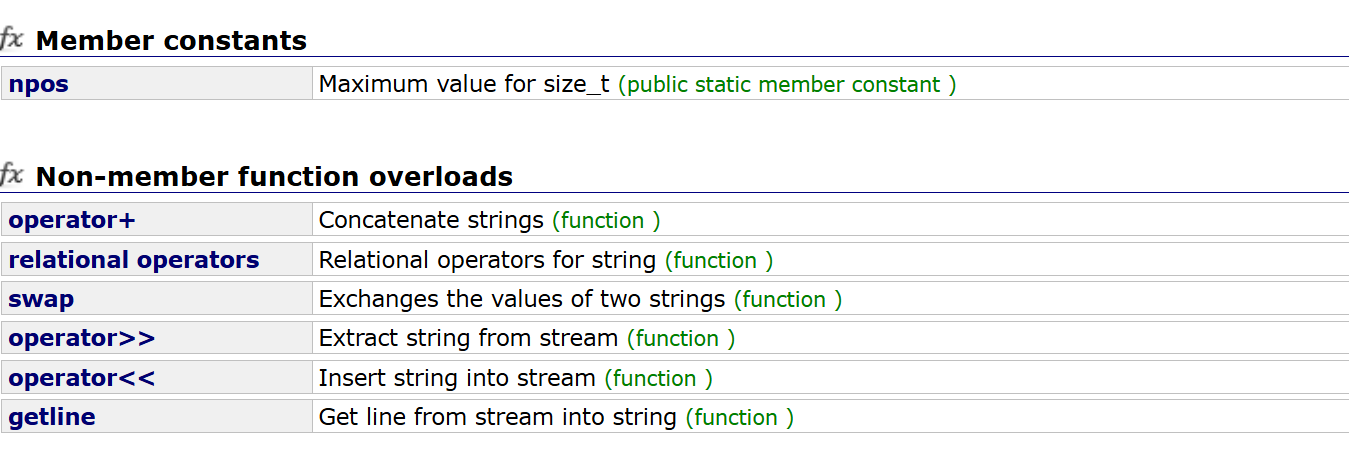
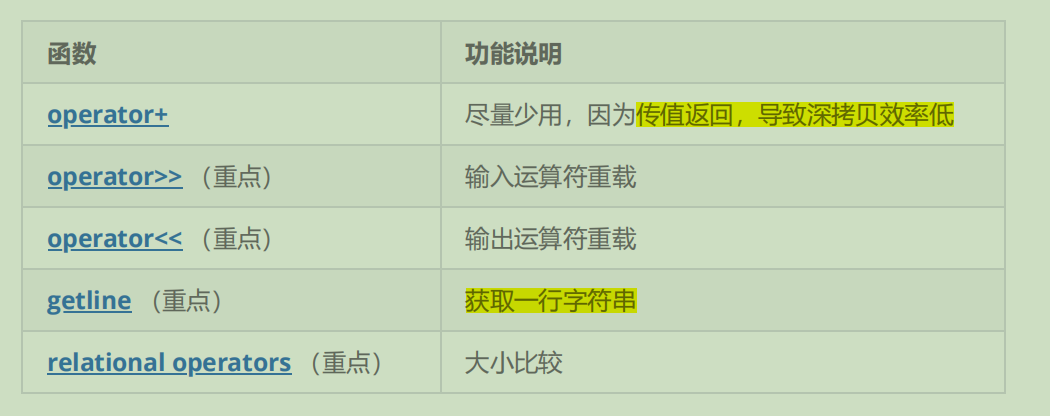 以上的接口介绍的没介绍的都可以自行查阅文档学习,不一一列举。
以上的接口介绍的没介绍的都可以自行查阅文档学习,不一一列举。
2.6 vs和g++下string结构的说明
2.6.1 vs下string的结构
class string
{
private:
char _buff[16];
char* _str;
size_t _size;
size_t _capacity;
};union _Bxty
{ // storage for small buffer or pointer to larger one
value_type _Buf[_BUF_SIZE];
pointer _Ptr;
char _Alias[_BUF_SIZE]; // to permit aliasing
} _Bx;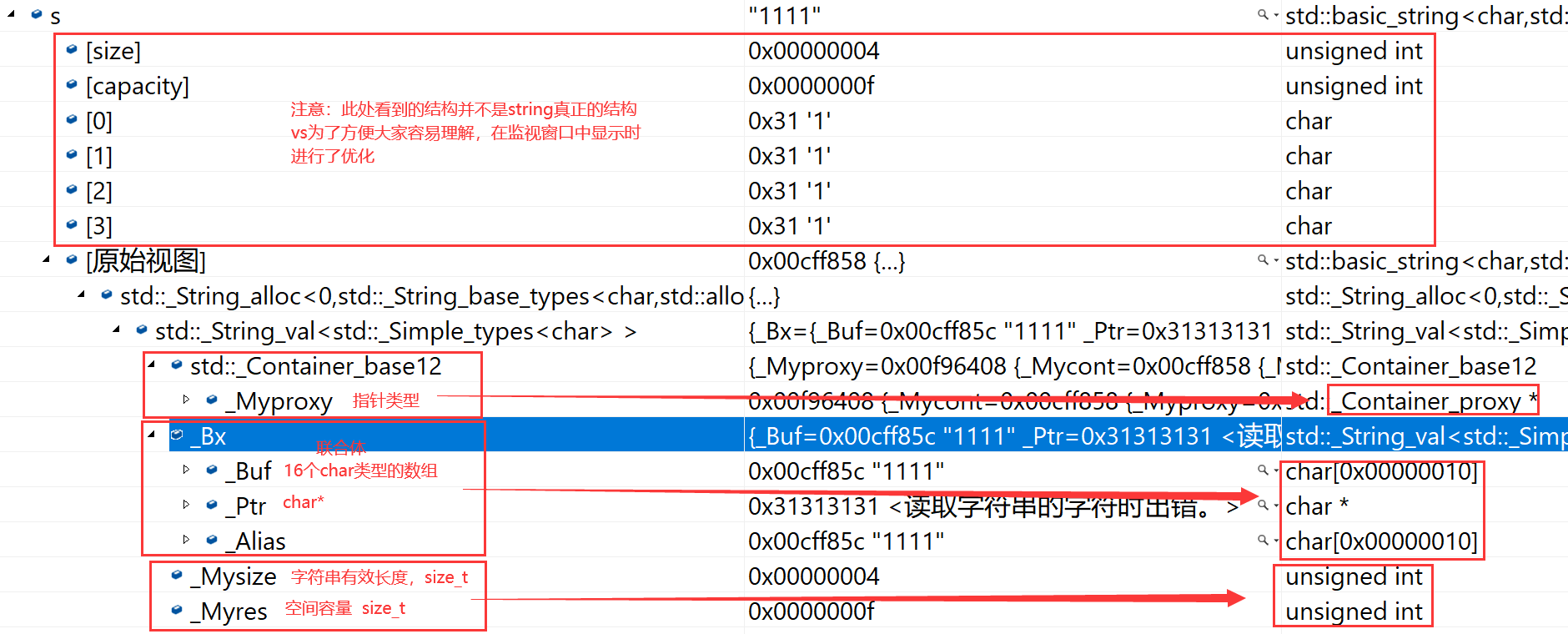
2.6.2 g++下string的结构
struct _Rep_base
{
_length;
size_type _M_capacity;
_Atomic_word _M_refcount;
};关于写时拷贝和引用计数,有兴趣的可以阅读一下这篇大佬写的文章:
C++ STL string的Copy-On-Write技术 | 酷 壳 - CoolShell
3.C++11的小语法(auto关键字和范围for)
3.1auto关键字(做类型推导)
#include<iostream>
using namespace std;
int func1()
{
return 10;
}
// 不能做参数
void func2(auto a)
{}
// 可以做返回值,但是建议谨慎使用
auto func3()
{
return 3;
}
int main()
{
int a = 10;
auto b = a;
auto c = 'a';
auto d = func1();
// 编译报错:rror C3531: “e”: 类型包含“auto”的符号必须具有初始值设定项
auto e;
cout << typeid(b).name() << endl;
cout << typeid(c).name() << endl;
cout << typeid(d).name() << endl;
int x = 10;
auto y = &x;
auto* z = &x;
auto& m = x;
cout << typeid(x).name() << endl;
cout << typeid(y).name() << endl;
cout << typeid(z).name() << endl;
auto aa = 1, bb = 2;
// 编译报错:error C3538: 在声明符列表中,“auto”必须始终推导为同一类型
auto cc = 3, dd = 4.0;
// 编译报错:error C3318: “auto []”: 数组不能具有其中包含“auto”的元素类型
auto array[] = { 4, 5, 6 };
return 0;
}#include<iostream>
#include <string>
#include <map>
using namespace std;
int main()
{
std::map<std::string, std::string> dict = { { "apple", "苹果" },{ "orange",
"橙子" }, {"pear","梨"} };
// auto的用武之地 简单方便快捷
//std::map<std::string, std::string>::iterator it = dict.begin();
auto it = dict.begin();
while (it != dict.end())
{
cout << it->first << ":" << it->second << endl;
++it;
}
return 0;
}3.2范围for(遍历方便)
#include<iostream>
#include <string>
#include <map>
using namespace std;
int main()
{
int array[] = { 1, 2, 3, 4, 5 };
// C++98的遍历
for (int i = 0; i < sizeof(array) / sizeof(array[0]); ++i)
{
array[i] *= 2;
}
for (int i = 0; i < sizeof(array) / sizeof(array[0]); ++i)
{
cout << array[i] << endl;
}
// C++11的遍历
for (auto& e : array)
e *= 2;
for (auto e : array)
cout << e << " " << endl;
string str("hello world");
for (auto ch : str)
{
cout << ch << " ";
}
cout << endl;
return 0;
}4.string类的实现
string.h
#define _CRT_SECURE_NO_WARNINGS 1
#pragma once
#include<iostream>
#include<string>
#include<assert.h>
using namespace std;
namespace sy
{
class string
{
public:
typedef char* iterator;
typedef const char* const_iterator;
iterator begin()
{
return _str;
}
iterator end()
{
return _str + _size;
}
const_iterator begin() const
{
return _str;
}
const_iterator end() const
{
return _str + _size;
}
/*string()
:_str(new char[1]{'\0'})
,_size(0)
,_capacity(0)
{}*/
// 短小频繁调用的函数,可以直接定义到类里面,默认是inline
string(const char* str = "")
{
_size = strlen(str);
// _capacity不包含\0
_capacity = _size;
_str = new char[_capacity + 1];
strcpy(_str, str);
}
// 深拷贝问题
// s2(s1)
/*string(const string& s)
{
_str = new char[s._capacity + 1];
strcpy(_str, s._str);
_size = s._size;
_capacity = s._capacity;
}*/
void swap(string& s)
{
std::swap(_str, s._str);
std::swap(_size, s._size);
std::swap(_capacity, s._capacity);
}
// s2(s1)
// 现代写法
string(const string& s)
{
string tmp(s._str);
swap(tmp);
}
// s2 = s1
// s1 = s1
/*string& operator=(const string& s)
{
if (this != &s)
{
delete[] _str;
_str = new char[s._capacity + 1];
strcpy(_str, s._str);
_size = s._size;
_capacity = s._capacity;
}
return *this;
}*/
// s1 = s3;
//string& operator=(const string& s)
//{
// if (this != &s)
// {
// //string tmp(s._str);
// string tmp(s);
// swap(tmp);
// }
// return *this;
//}
// s1 = s3;
string& operator=(string tmp)
{
swap(tmp);
return *this;
}
~string()
{
if (_str)
{
delete[] _str;
_str = nullptr;
_size = _capacity = 0;
}
}
const char* c_str() const
{
return _str;
}
void clear()
{
_str[0] = '\0';
_size = 0;
}
size_t size() const
{
return _size;
}
size_t capacity() const
{
return _capacity;
}
char& operator[](size_t pos)
{
assert(pos < _size);
return _str[pos];
}
const char& operator[](size_t pos) const
{
assert(pos < _size);
return _str[pos];
}
/*void copy_on_write()
{
if (count > 1)
{
深拷贝
}
}*/
void reserve(size_t n);
void push_back(char ch);
void append(const char* str);
string& operator+=(char ch);
string& operator+=(const char* str);
void insert(size_t pos, char ch);
void insert(size_t pos, const char* str);
void erase(size_t pos, size_t len = npos);
size_t find(char ch, size_t pos = 0);
size_t find(const char* str, size_t pos = 0);
string substr(size_t pos = 0, size_t len = npos);
private:
//char _buff[16];
char* _str = nullptr;
size_t _size = 0;
size_t _capacity = 0;
//static const size_t npos = -1;
static const size_t npos;
/*static const int N = 10;
int buff[N];*/
};
bool operator<(const string& s1, const string& s2);
bool operator<=(const string& s1, const string& s2);
bool operator>(const string& s1, const string& s2);
bool operator>=(const string& s1, const string& s2);
bool operator==(const string& s1, const string& s2);
bool operator!=(const string& s1, const string& s2);
ostream& operator<<(ostream& out, const string& s);
istream& operator>>(istream& in, string& s);
}string.cpp
#include"string.h"
namespace sy
{
//静态成员变量⼀定要在类外进⾏初始化
const size_t string::npos = -1;
void string::reserve(size_t n)
{
if (n > _capacity)
{
char* tmp = new char[n + 1];
strcpy(tmp, _str);
delete[] _str;
_str = tmp;
_capacity = n;
}
}
void string::push_back(char ch)
{
if (_size == _capacity)
{
reserve(_capacity == 0 ? 4 : _capacity * 2);
}
_str[_size] = ch;
++_size;
_str[_size] = '\0';
}
string& string::operator+=(char ch)
{
push_back(ch);
return *this;
}
void string::append(const char* str)
{
size_t len = strlen(str);
if (_size + len > _capacity)
{
// 大于2倍,需要多少开多少,小于2倍按2倍扩
reserve(_size + len > 2 * _capacity ? _size + len : 2 * _capacity);
}
strcpy(_str + _size, str);
_size += len;
}
string& string::operator+=(const char* str)
{
append(str);
return *this;
}
void string::insert(size_t pos, char ch)
{
assert(pos <= _size);
if (_size == _capacity)
{
reserve(_capacity == 0 ? 4 : _capacity * 2);
}
// 挪动数据
size_t end = _size + 1;
while (end > pos)
{
_str[end] = _str[end - 1];
--end;
}
_str[pos] = ch;
++_size;
}
void string::insert(size_t pos, const char* s)
{
assert(pos <= _size);
size_t len = strlen(s);
if (_size + len > _capacity)
{
// 大于2倍,需要多少开多少,小于2倍按2倍扩
reserve(_size + len > 2 * _capacity ? _size + len : 2 * _capacity);
}
size_t end = _size + len;
while (end > pos + len - 1)
{
_str[end] = _str[end - len];
--end;
}
for (size_t i = 0; i < len; i++)
{
_str[pos + i] = s[i];
}
_size += len;
}
void string::erase(size_t pos, size_t len)
{
assert(pos < _size);
if (len >= _size - pos)
{
_str[pos] = '\0';
_size = pos;
}
else
{
for (size_t i = pos + len; i <= _size; i++)
{
_str[i - len] = _str[i];
}
_size -= len;
}
}
size_t string::find(char ch, size_t pos)
{
assert(pos < _size);
for (size_t i = pos; i < _size; i++)
{
if (_str[i] == ch)
{
return i;
}
}
//找不到返回-1
return npos;
}
size_t string::find(const char* str, size_t pos)
{
assert(pos < _size);
const char* ptr = strstr(_str + pos, str);
if (ptr == nullptr)
{
return npos;
}
else
{
return ptr - _str;
}
}
string string::substr(size_t pos, size_t len)
{
assert(pos < _size);
// len大于剩余字符长度,更新一下len
if (len > _size - pos)
{
len = _size - pos;
}
string sub;
sub.reserve(len);
for (size_t i = 0; i < len; i++)
{
sub += _str[pos + i];
}
return sub;
}
bool operator<(const string& s1, const string& s2)
{
return strcmp(s1.c_str(), s2.c_str()) < 0;
}
bool operator<=(const string& s1, const string& s2)
{
return s1 < s2 || s1 == s2;
}
bool operator>(const string& s1, const string& s2)
{
return !(s1 <= s2);
}
bool operator>=(const string& s1, const string& s2)
{
return !(s1 < s2);
}
bool operator==(const string& s1, const string& s2)
{
return strcmp(s1.c_str(), s2.c_str()) == 0;
}
bool operator!=(const string& s1, const string& s2)
{
return !(s1 == s2);
}
ostream& operator<<(ostream& out, const string& s)
{
for (auto ch : s)
{
out << ch;
}
return out;
}
istream& operator>>(istream& in, string& s)
{
s.clear();
const int N = 256;
char buff[N];
int i = 0;
char ch;
//in >> ch;
ch = in.get();
while (ch != ' ' && ch != '\n')
{
buff[i++] = ch;
if (i == N - 1)
{
buff[i] = '\0';
s += buff;
i = 0;
}
//in >> ch;
ch = in.get();
}
if (i > 0)
{
buff[i] = '\0';
s += buff;
}
return in;
}
}test.cpp
#include"string.h"
namespace sy
{
void test_string1()
{
string s1;
string s2("hello world");
cout << s1.c_str() << endl;
cout << s2.c_str() << endl;
for (size_t i = 0; i < s2.size(); i++)
{
s2[i] += 2;
}
cout << s2.c_str() << endl;
for (auto e : s2)
{
cout << e << " ";
}
cout << endl;
string::iterator it = s2.begin();
while (it != s2.end())
{
//*it += 2;
cout << *it << " ";
++it;
}
cout << endl;
}
void test_string2()
{
string s1("hello world");
s1 += 'x';
s1 += '#';
cout << s1.c_str() << endl;
s1 += "hello";
cout << s1.c_str() << endl;
s1.insert(5, '$');
cout << s1.c_str() << endl;
s1.insert(0, '$');
cout << s1.c_str() << endl;
string s2("hello world");
cout << s2.c_str() << endl;
s2.insert(5, "$$$");
cout << s2.c_str() << endl;
s2.insert(0, "$$$&&&&&&&&&&&&&&&&&&&&&&&&");
cout << s2.c_str() << endl;
}
void test_string3()
{
string s1("hello world");
s1.erase(6, 100);
cout << s1.c_str() << endl;
string s2("hello world");
s2.erase(6);
cout << s2.c_str() << endl;
string s3("hello world");
s3.erase(6, 3);
cout << s3.c_str() << endl;
}
void test_string4()
{
string s("test.cpp.zip");
size_t pos = s.find('.');
string suffix = s.substr(pos);
cout << suffix.c_str() << endl;
string copy(s);
cout << copy.c_str() << endl;
s = suffix;
cout << suffix.c_str() << endl;
cout << s.c_str() << endl;
s = s;
cout << s.c_str() << endl;
}
void test_string5()
{
string s1("hello world");
string s2("hello world");
cout << (s1 < s2) << endl;
cout << (s1 == s2) << endl;
cout << ("hello world" < s2) << endl;
cout << (s1 == "hello world") << endl;
cout << ("hello world" == "hello world") << endl;
cout << s1 << s2 << endl;
string s0;
cin >> s0;
cout << s0 << endl;
}
void test_string6()
{
string s1("hello world");
string s2 = s1;
cout << s1 << endl;
cout << s2 << endl;
string s3("xxxxxxxxxxxxxx");
s1 = s3;
cout << s1 << endl;
cout << s3 << endl;
}
void test_string7()
{
string s1("hello world");
string s2("xxxxxxxxxxxxxxxxxxxxxxxx");
std::swap(s1, s2);
s1.swap(s2);
}
}
int main()
{
sy::test_string1();
sy::test_string2();
sy::test_string3();
sy::test_string4();
sy::test_string5();
sy::test_string6();
sy::test_string7();
return 0;
}5.浅拷贝和深拷贝问题
5.1浅拷贝
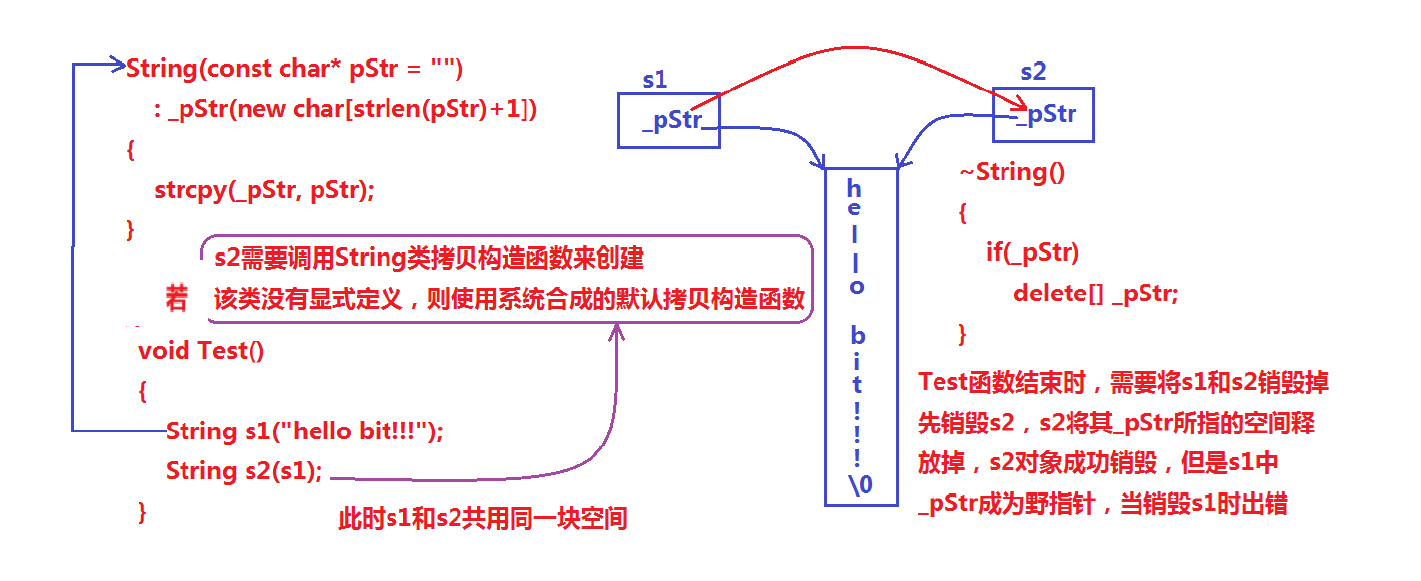
5.1深拷贝
如果一个类中涉及到资源的管理,其拷贝构造函数、赋值运算符重载以及析构函数必须要显式给出。一般情况都是按照深拷贝方式提供。

6.string 在线OJ题目
class Solution {
public:
string addStrings(string num1, string num2)
{
string str;
int end1=num1.size()-1,end2=num2.size()-1;
int next=0;
while(end1>=0 || end2>=0)
{
int val1 = end1 >=0 ? num1[end1--]-'0' : 0;
int val2 = end2 >=0 ? num2[end2--]-'0' : 0;
int ret=val1+val2+next;
next=ret / 10;
ret=ret % 10;
str +=('0'+ret);
}
if(next==1)
str+='1';
reverse(str.begin(),str.end());
return str;
}
};class Solution {
public:
bool isLetter(char ch)
{
if(ch >= 'a' && ch <= 'z')
return true;
if(ch >= 'A' && ch <= 'Z')
return true;
return false;
}
string reverseOnlyLetters(string S)
{
if(S.empty())
return S;
size_t begin = 0, end = S.size()-1;
while(begin < end)
{
while(begin < end && !isLetter(S[begin]))
++begin;
while(begin < end && !isLetter(S[end]))
--end;
swap(S[begin], S[end]);
++begin;
--end;
}
return S;
}
};class Solution {
public:
//1. 分别对字符串进行正序查询和反序查询
// 2. 如果所查询的字符下标相等,说明此字符只出现了一次
int firstUniqChar(string s)
{
for(int i=0; i<s.size(); ++i)
{
int index = s.find(s[i]);
int reverse_index = s.rfind(s[i]);
if(index == reverse_index)
return i;
}
return -1;
}
};class Solution {
public:
int firstUniqChar(string s)
{
int a[256]={0};
for(int i=0;i<s.size();i++)
{
a[s[i]]+=1;
}
for(int i=0;i<s.size();i++)
{
if(1==a[s[i]])
{
return i;
}
}
return -1;
}
};#include <iostream>
#include <string>
#include <algorithm>
using namespace std;
int main()
{
string str;
getline(cin, str);
reverse(str.begin(), str.end());
string::iterator it = str.begin();
int count = 0;
while (it != str.end() && * it != ' ')
{
count++;
++it;
}
cout << count << endl;
return 0;
}#include<iostream>
#include<string>
using namespace std;
int main()
{
string line;
// 不要使用cin>>line,因为会它遇到空格就结束了
// while(cin>>line)
while(getline(cin, line))
{
size_t pos = line.rfind(' ');
cout<<line.size()-pos-1<<endl;
}
return 0;
}class Solution {
public:
bool isletter(char ch)
{
if((ch >= 'a' && ch <= 'z') ||
(ch >='A' && ch <='Z') ||
(ch >='0' && ch <= '9'))
{
return true;
}
return false;
}
bool isPalindrome(string s)
{
//全部转成小写字母
for(auto& ch :s)
{
if(ch >='A' && ch <='Z')
{
ch+=32;
}
}
int begin=0;
int end=s.size()-1;
while(begin < end)
{
while(begin < end && !isletter(s[begin]))
{
++begin;
}
while(begin < end && !isletter(s[end]))
{
--end;
}
if(s[begin]!=s[end])
{
return false;
}
else
{
++begin;
--end;
}
}
return true;
}
};class Solution {
public:
void Reverse(string& s, int start, int end)
{
char tmp;
end--;
while (start < end)
{
tmp = s[start];
s[start] = s[end];
s[end] = tmp;
start++;
end--;
}
}
string reverseStr(string s, int k)
{
int len = s.size();
for (int i = 0; i < len; i += 2 * k)
{
if (i + k < len)
Reverse(s, i, i + k);
else
Reverse(s, i, len);
}
return s;
}
};557. 反转字符串中的单词 III - 力扣(LeetCode)
class Solution {
public:
string reverseWords(string s)
{
string::iterator it = s.begin();
int count = 0;
int end = 0;
auto ptr = s.begin();
while (it != s.end())
{
if(*it == ' ')
{
std::reverse(ptr, s.begin() + count);
ptr = s.begin() + count + 1;
}
count++;
it++;
}
std::reverse(ptr, s.end());
return s;
}
};class Solution {
public:
void MulItem(string& tmp, string& num1, char a)
{
int i = 0, sign = 0;
int mul = 0;
while (i < num1.size())
{
mul = (num1[i] - '0') * (a - '0') + sign;
if (mul >= 10)
{
sign = mul / 10;
mul %= 10;
}
else
sign = 0;
tmp.push_back(mul + '0');
i++;
}
if (sign > 0)
tmp.push_back(sign + '0');
}
//对应位相加,sign进位采用引用传递
int AddItem(int a, int b, int& sign)
{
int add = a + b + sign;
if (add >= 10)
{
sign = 1;
add -= 10;
}
else
sign = 0;
return add;
}
//错位相加
void MoveAdd(string& result, string& tmp, int k)
{
int i, j;
i = k;
j = 0;
int sign = 0;
while (i < result.size() && j < tmp.size())
{
result[i] = AddItem(result[i] - '0', tmp[j] - '0', sign) + '0';
i++;
j++;
}
while (i < result.size() && sign)
{
result[i] = AddItem(result[i] - '0', 0, sign) + '0';
i++;
}
while (j < tmp.size())
{
int v = AddItem(0, tmp[j] - '0', sign);
result.push_back(v + '0');
j++;
}
if (sign)
result.push_back(sign + '0');
}
string multiply(string num1, string num2)
{
//先翻转数据,方便进位处理
reverse(num1.begin(), num1.end());
reverse(num2.begin(), num2.end());
string tmp, result;
for (int i = 0; i < num2.size(); ++i)
{
//使用num2的每一个数据乘以num1
MulItem(tmp, num1, num2[i]);
//将乘得的结果进行错位相加
MoveAdd(result, tmp, i);
tmp.clear();
}
//处理前导0
while (result.size() != 1 && result.back() == '0')
result.pop_back();
//翻转数据,恢复数据
reverse(result.begin(), result.end());
return result;
}
}; C++ string类全面解析
C++ string类全面解析




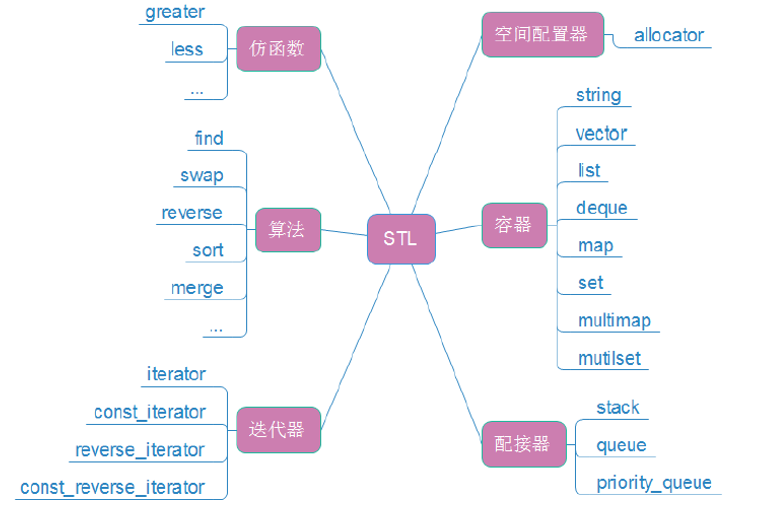

















 被折叠的 条评论
为什么被折叠?
被折叠的 条评论
为什么被折叠?








